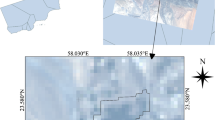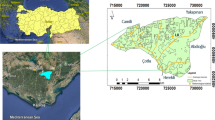Abstract
Improvements in irrigation management are urgently needed in regions where water resources for irrigation are being depleted. This paper combines a water balance model with satellite-based remote-sensing estimates of evapotranspiration (ET) to provide accurate irrigation scheduling guidelines for individual fields. The satellite-derived ET was used in the daily soil water balance model to improve accuracy of field-by-field ET demands and subsequent field-scale irrigation schedules. The combination of satellite-based ET with daily soil water balance incorporates the advantages of satellite remote-sensing and daily calculation time steps, namely, high spatial resolution and high temporal resolution. The procedure was applied to Genil–Cabra Irrigation Scheme of Spain, where irrigation water supply is often limited by regional drought. Compared with traditional applications of water balance models (i.e. without the satellite-based ET), the combined procedure provided significant improvements in irrigation schedules for both the average condition and when considering field-to-field variability. A 24% reduction in application of water was estimated for cotton if the improved irrigation schedules were followed. Irrigation efficiency calculated using satellite-based ET and actual applied irrigation water helped to identify specific agricultural fields experiencing problems in water management, as well as to estimate general irrigation efficiencies of the scheme by irrigation and crop type. Estimation of field irrigation efficiency ranged from 0.72 for cotton to 0.90 for sugar beet.







Similar content being viewed by others
References
Allen RG, Pereira LS, Raes D, Smith M (1998) Crop evapotranspiration: guidelines for computing crop water requirements. FAO irrigation and drainage paper 56. FAO, Rome
Allen RG, Tasumi M, Morse A, Trezza R (2005a) A landsat-based energy balance and evapotranspiration model in western US water rights regulation and planning. Irrig Drain Syst 19:251–268
Allen RG, Pereira LS, Smith M, Raes D, Wright JL (2005b) FAO-56 dual crop coefficient method for estimating evaporation form soil and application extensions. J Irrig Drain Eng ASCE 131(1):2–13
Allen RG, Trezza R, Tasumi M (2006) Analytical integrated functions for daily solar radiation on slopes for use in energy balance and evapotranspiration studies. Agric Meteorol 139:55–73
Allen RG, Tasumi M, Trezza R (2007a) Satellite-based energy balance for mapping evapotranspiration with internalized calibration (METRIC)-Model. J Irrig Drain Eng ASCE 133(4):380–394
Allen RG, Tasumi M, Morse A, Trezza R, Wright JL, Bastiaanssen W, Kramber W, Lorite IJ, Robison CW (2007b) Satellite-based energy balance for mapping evapotranspiration with internalized calibration (METRIC)–Applications. J Irrig Drain Eng ASCE 133(4):395–406
ASCE-EWRI (2005) The ASCE standardized reference evapotranspiration equation. Environmental and water resources institute of the ASCE standardization of reference evapotranspiration task committee. American Society of Civil Engineers, Reston, p 216
Bandara KMPS (2003) Monitoring irrigation performance in Sri Lanka with high-frequency satellite measurements during the dry season. Agric Water Manage 58:159–170
Bastiaanssen WGM, Bos MG (1999) Irrigation performance indicators based on remotely sensed data: a review of literature. Irrig Drain Syst 13:291–311
Bastiaanssen WGM, Menenti M, Feddes RA, Holtslag AAM (1998) A remote sensing surface energy balance algorithm for land (SEBAL): 1. formulation. J Hydrol 212–213:198–212
Bastiaanssen WGM, Brito RAL, Bos MG, Souza RA, Cavalcanti EB, Bakker MM (2001) Low cost satellite data for monthly irrigation performance monitoring: benchmarks from Nilo Coelho, Brazil. Irrig Drain Syst 15:53–79
Bastiaanssen WGM, Noordman EJM, Pelgrum H, Davids G, Thoreson BP, Allen RG (2005) SEBAL model with remotely sensed data to improve water-resources management under actual field conditions. J Irrig Drain Eng ASCE 131(1):85–93
Black TA, Spittlehouse DL, Novak MD, Price DT (1989) Estimation of areal ET. International Association of Hydrological Sciences, IAHS red book 177. Institute of Hydrology, Wallingford
Burt CM, Clemmens AJ, Strelkoff TS, Solomon KH, Bliesner RD, Hardy LA, Howell TA, Eisenhauer DE (1997) Irrigation performance measures: efficiency and uniformity. J Irrig Drain Eng ASCE 123:423–442
Coelho MB, Villalobos FJ, Mateos L (2003) Modeling root growth and the soil-plant-atmosphere continuum of cotton crops. Agric Water Manage 60:99–118
Consoli S, D’Urso G, Toscano A (2006) Remote sensing to estimate ET-fluxes and the performance of an irrigation district in southern Italy. Agric Water Manage 81:295–314
Droogers P, Bastiaanssen WGM (2002) Irrigation performance using hydrological and remote sensing modelling. J Irrig Drain Eng ASCE 128(1):11–18
Dugas WA, Fritschen LJ, Gay LW, Held AA, Matthias AD, Reicosky DC, Steduto P, Steiner JL (1991) Bowen ratio, eddy correlation and portable chamber measurements of sensible and latent heat flux over irrigated spring wheat. Agric Meteorol 56:1–20
Er-Raki S, Chehbouni A, Guemouria N, Duchemin B, Ezzahar J, Hadria R (2007) Combining FAO-56 model and ground-based remote sensing to estimate water consumptions of wheat crops in a semi-arid region. Agric Water Manage 87:41–54
Gavilán P, Lorite IJ, Tornero S, Berengena J (2006) Regional calibration of Hargreaves equation for estimating reference ET in a semiarid environment. Agric Water Manage 81:257–281
Guerif M, Duke CL (2000) Adjustment procedures of a crop model to the site specific characteristics of soil and crop using remote sensing data assimilation. Agric Ecosyst Environ 81:57–69
Hsiao TC, Steduto P, Fereres E (2007) A systematic and quantitative approach to improve water use efficiency in agriculture. Irrig Sci 25:209–231
Kite G (2000) Using a basin-scale hydrological model to estimate crop transpiration and soil evaporation. J Hydrol 229:59–69
Kite G, Droogers P (2000) Comparing ET estimates from satellites, hydrological models and field data. J Hydrol 229:3–18
Lorite IJ, Mateos L, Fereres E (2004a) Evaluating irrigation performance in a Mediterranean environment. I. Model and general assessment of an irrigation scheme. Irrig Sci 23:77–84
Lorite IJ, Mateos L, Fereres E (2004b) Evaluating irrigation performance in a Mediterranean environment. II. Variability among crops and farmers. Irrig Sci 23:85–92
Mateos L (2006) A simulation study of comparison of the evaluation procedures for three irrigation methods. Irrig Sci 25(1):75–83
Mo X, Liu S, Lin Z, Xu Y, Xiang Y, McVicar TR (2005) Prediction of crop yield, water consumption and water use efficiency with a SVAT-crop growth model using remotely sensed data on the North China Plain. Ecol Model 183:301–322
Ray SS, Dadhwal VK (2001) Estimation of crop evapotranspiration of irrigation command area using remote sensing and GIS. Agric Water Manage 49:239–249
Roerink GJ, Bastiaanssen WGM, Chambouleyron J, Menenti M (1997) Relating crop water consumption to irrigation water supply by remote sensing. Water Resour Manag 11:445–465
Sanaee-Jahromi S, Feyen J (2001) Spatial and temporal variability performance of the water delivery in irrigation schemes. Irrig Drain Syst 15:215–233
Tasumi M, Allen RG (2007) Satellite-based ET mapping to assess variation in ET with timing of crop development. Agric Water Manage 88:54–62
Tasumi M, Trezza R, Allen RG, Wright J (2005a) Satellite-based energy balance to assess within-population variance of crop coefficient curves. J Irrig Drain Eng ASCE 131(1):94–109
Tasumi M, Trezza R, Allen RG, Wright J (2005b) Operational aspects of satellite-based energy balance models for irrigated crops in the semi-arid U.S. Irrig Drain Syst 19:355–376
USDA-Soil Conservation Service (1972) National engineering handbook. USDA–SCS, US Government Printing Office, Washington, DC
Van Aelst PV, Ragab RA, Feyen J, Raes D (1988) Improving irrigation management by modelling the irrigation schedule. Agric Water Manag 13:113–125
Williams JR (1991) Runoff and water erosion. In: Hanks J, Ritchie JT (eds). Modeling plant and soil system. ASA/CSSA/SSSA, Madison, pp 439–455
Wu IP (1988) Linearized water application function for drip irrigation schedules. Trans Am Soc Agric Eng 31:1743–1749
Acknowledgments
The authors thank Mr Berlanga and Mrs Carmona (manager and technician of the Genil–Cabra Irrigation Scheme), Dr. Mateos, the Spanish Ministry of Education and Science (Grants INIA-RTA05-0025 and INIA-TRT06-0014), and the University of Idaho for their support.
Author information
Authors and Affiliations
Corresponding author
Additional information
Communicated by S. Azam-Ali.
Rights and permissions
About this article
Cite this article
Santos, C., Lorite, I.J., Tasumi, M. et al. Integrating satellite-based evapotranspiration with simulation models for irrigation management at the scheme level. Irrig Sci 26, 277–288 (2008). https://doi.org/10.1007/s00271-007-0093-9
Received:
Accepted:
Published:
Issue Date:
DOI: https://doi.org/10.1007/s00271-007-0093-9




